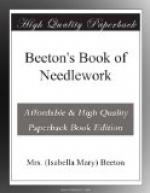The following illustrations are specimens of ancient and modern laces from Mrs. Bury Palliser’s collection:—
[Illustration: 419.—Dalecarlian Lace.]
[Illustration: 420.—Old Mechlin.]
[Illustration: 421.—Mechlin Lace (Queen Charlotte’s).]
No. 419 shows Dalecarlian lace, made by the women of Dalecarlia. This is a coarse kind of lace, and is sewn on caps, &c., and, although highly starched, is never washed, for fear of destroying its coffee-coloured tint, which, it appears, is as much prized now by the Swedish rustics as it was by English ladies in the last century.
[Illustration: 422.—Buckingham Point Trolly, 1851 (Black Lace).]
Both these specimens of Mechlin belonged to Queen Charlotte, who much admired this elegant lace.
No. 423.—The Bedford plaited lace is an improvement on the old Maltese.
Honiton guipure lace is distinguished by the groundwork being of various stitches, in place of being sewn upon a net ground. The application of Honiton sprigs upon bobbin net has been of late years almost superseded by this modern guipure. The sprigs, when made, are sewn upon a piece of blue paper and united on the pillow with “cutworks” or “purlings,” or else joined with the needle by various stitches—lacet, point, reseau, cutwork, button-hole, and purling.
[Illustration: 423.—Bedford Plaited Lace (1851).]
Those who wish to study lace and lace-making should
read Mrs. Bury
Palliser’s History of Lace (Sampson Low
and Marston).
[Illustration: 424.—Honiton Guipure Lace.]
POINT LACE.
The materials required for this elegant branch of needlework are neither numerous nor expensive. TRACING CLOTH, LEATHER, or TOILE CIREE, various BRAIDS and CORDS, LINEN THREAD and two or three sizes of needles, scissors and thimble. TRACING CLOTH is required when ladies copy point lace patterns, and is the most convenient mode of taking them, as the design can be worked upon the tracing cloth, which, though transparent, is very strong; the price is 1s. 6d. per yard. Fine LEATHER is the material upon which bought patterns are usually traced, and is decidedly more pleasant to work on than is any other material. In selecting patterns ladies should choose those traced upon green leather in preference to scarlet or buff, as green is better for the eyesight than any other colour.
[Illustration: 425.—Point Lace Scissors.]
TOILE CIREE is only a substitute for leather, and is not as pleasant to work upon in warm weather.
The needles employed are usually Messrs. Walker’s needles, Nos. 9 and 10. The scissors should be small, sharp, and pointed, as in illustration No. 425. An ivory thimble may be safely employed in this light work.
[Illustration: 426.—Linen Braid.]
[Illustration: 427.—Linen Braid.]




